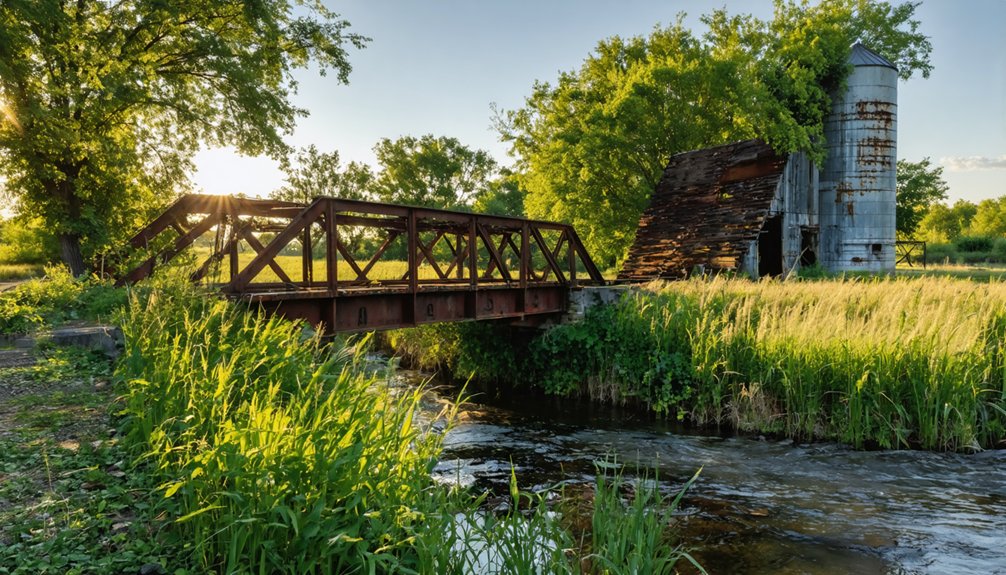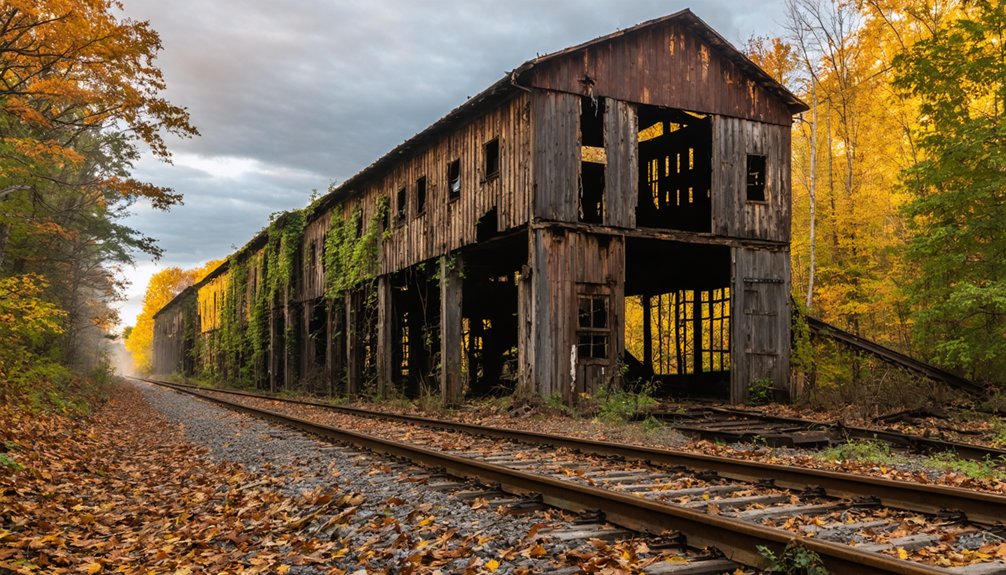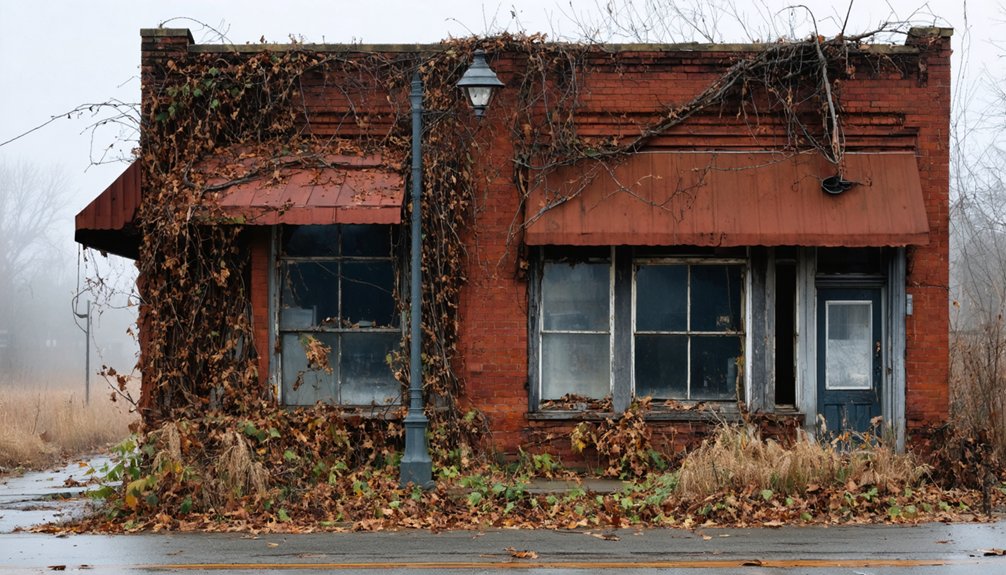You’ll find Tremont’s fascinating story along Lake Michigan’s southern shore, where it began as City West in 1836 before economic troubles drove residents away by 1839. The settlement later revived as New City West, eventually becoming Tremont – a bustling railroad hub and tourist destination by 1908. While sawmill operations, hotels, and the South Shore Line once defined this community, today you’ll discover only traces of its past within Indiana Dunes State Park.
Key Takeaways
- Tremont emerged as a settlement in Indiana after City West’s collapse, featuring a cooperage, hotel, and tavern during its peak years.
- The South Shore Line’s arrival in 1908 transformed Tremont into a transit hub and tourist destination for Chicago weekenders.
- The town’s decline began with the 1876 sawmill fire, leading to economic collapse and widespread abandonment.
- Industrial remnants, including foundation stones and railroad ties, are still visible today near the old Dunes Creek dam site.
- Tremont transitioned from a bustling lumber community to a ghost town as families left seeking employment elsewhere.
The Rise and Fall of City West
While Chicago emerged as a dominant Great Lakes port in the 1830s, ambitious investors established City West in 1836 along Lake Michigan’s southern shore as its potential rival.
You’d have found a bustling 25-block settlement with 40 homes, a sawmill, and a grand 22-room hotel, all poised for greatness.
Today, the remnants of this once-promising town lie within Indiana Dunes State Park.
But you wouldn’t want to invest there for long. The Panic of 1837 struck, triggering a devastating economic decline that shattered City West’s dreams.
Property values plummeted from hundreds of dollars per acre to just pennies. By 1839, this promising development had transformed into a ghost town as residents fled, leaving their homes and businesses behind.
The settlement lacked essential community foundations like schools and churches.
A destructive forest fire in the 1850s sealed the settlement’s fate, consuming what little remained of the failed Chicago rival.
Birth of New City West to Tremont
After City West’s demise, a smaller settlement emerged southeast of the original site along the Detroit Chicago Road, a popular stagecoach route in the mid-1800s. This New City development nestled between three prominent dunes – Mount Tom, Mount Holden, and Mount Green – and featured a cooperage, hotel, and tavern during its peak years. The settlement faced competition from Michigan City’s growth, which had successfully established itself as a key port town by 1830. Like Berlin’s City West district, it struggled to maintain its commercial significance over time.
Unlike its predecessor, this settlement remained modest without formal incorporation. By the 1870s, you’d have found the community declining, though the 1876 construction of a one-room schoolhouse showed lingering life.
The Tremont evolution began in the early 1900s when the area adopted its new name, inspired by the “three mountains.” The South Shore Railroad’s arrival in 1908 and Indiana Dunes State Park’s establishment in 1926 transformed the ghost town into a tourist destination.
Life in a Thriving Railroad Hub
The arrival of the South Shore Line in 1908 marked the beginning of Tremont’s railroad era, transforming the quiet settlement into a bustling transit hub. The railroad culture shaped every aspect of daily life, with residents planning their routines around train schedules and finding work in rail-related jobs. Similar to the Illinois Central Railroad acquisition of other small lines, the town’s rail operations eventually underwent ownership changes. The Prairie Club members frequently organized outdoor excursions and hikes, making Tremont a popular destination for nature enthusiasts.
Though never formally incorporated as a town, Tremont’s community connections flourished around the station at U.S. Highway 12 and County Road 100 East.
You’d have experienced:
- Local businesses like hotels and taverns catering to travelers
- Quick access to Chicago for shopping and employment
- Social gatherings centered on train arrivals and departures
- Children attending the City West schoolhouse alongside railroad workers’ families
The electric interurban rail didn’t just move people—it created a vibrant community united by shared reliance on the tracks.
Tourism’s Golden Age
You’ll find it hard to imagine Tremont in its tourism heyday when up to four hotels and numerous vacation cabins catered to Chicago weekenders seeking lakefront recreation.
The Prairie Club, established in 1908, made Tremont its base for organized hikes and outdoor adventures through the Indiana Dunes.
Before its decline, the area featured Jacob Bigelow’s Exchange, a prominent hotel and tavern that served as a gathering place for early visitors.
This influx of visitors transformed the small railroad town into a bustling tourist destination, complete with restaurants and gas stations serving travelers along Highway 12.
Visitors could see the Chicago skyline glow across Lake Michigan during sunset, making it a popular spot for evening gatherings.
Hotels and Cabins Flourished
During its tourism heyday, Tremont boasted up to four bustling hotels and inns along U.S. Highway 12, offering hotel experiences that catered to Chicago travelers exploring the Indiana Dunes.
You’d find accommodations ranging from traditional lodging to rustic cabin rentals, with some hotels featuring up to 22 rooms for guests seeking adventure in the surrounding natural areas.
- Hotels strategically positioned along the highway captured both tourist and business traffic
- Local property owners developed vacation cabins for extended-stay visitors
- Rental properties provided alternatives for those wanting a more immersive dunes experience
- Both hotels and cabins thrived year-round, especially during warm seasons when outdoor enthusiasts flocked to explore Mount Tom, Mount Holden, and Mount Green
Visitors seeking information about accommodations could consult the area’s disambiguation pages to locate specific hotels and their amenities.
Prairie Club Adventures
As Tremont’s lodging options expanded in the early 1900s, a pioneering organization emerged that would shape the region’s tourism landscape for decades to come.
The Prairie Club, founded in 1908, made Tremont their base for nature explorations, building a distinctive beach house atop a fifty-foot dune in 1913.
You could’ve joined their popular “Saturday Afternoon Walking Trips,” rented an affordable cot in the screened sleeping porches, or participated in community engagement events that drew thousands.
Their well-marked trails led you through diverse landscapes – from Mount Tom’s heights to Tamarack Swamp’s mysteries.
The Club published detailed guides about local flora and fauna, while organizing mass gatherings to protect the dunes from industrial threats. Led by renowned botanist Henry Cowles, their scientific studies helped establish the foundations of plant ecology in North America.
They coined the rallying cry “Save the Dunes,” forever linking Tremont with environmental conservation.
The Sawmill Legacy
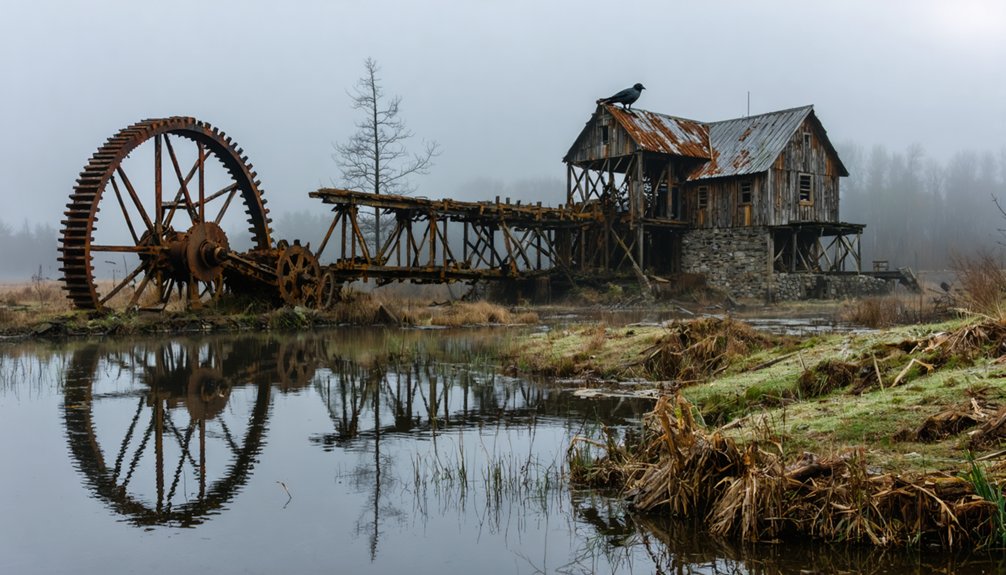
When Tremont’s sawmill operations ceased in 1876, you’d find the town’s economic heart grinding to a complete stop as timber resources dwindled.
Workers and their families quickly abandoned the settlement, leaving behind empty homes and shops that once bustled with activity.
Today, you can spot traces of Tremont’s industrial past in the weathered remnants of the sawmill’s foundation stones and scattered railroad ties near the old Dunes Creek dam site.
Economic Heart Stops 1876
The devastating 1876 fire that consumed Tremont’s sawmill marked the beginning of the town’s irreversible decline.
You can trace the economic decline through the mass exodus of residents who’d relied on the mill for their livelihood. The community’s reliance on this single industry proved fatal, as the fire effectively stopped Tremont’s economic heart from beating.
- The sawmill had been paying workers $1.25 per thousand board feet produced
- Secondary businesses like cooper shops and transport services quickly folded
- Many original timber-related enterprises had already been pruned by 1876
- The fire ended Tremont’s role as an essential lumber distribution hub
The destruction wasn’t just about losing a building – it represented the end of an era that had defined Tremont’s identity since its founding in the late 1830s.
Workers Leave Town Behind
Following the mill’s destruction, Tremont’s workers faced a stark reality that would reshape their lives and the town’s future.
You’d find worker families packing up their belongings, leaving behind the tight-knit community they’d built through years of shared labor and seasonal traditions.
The exodus wasn’t just about losing jobs – it marked the end of an intricate social fabric woven through generations of sawmill work.
Those who’d once collaborated in felling trees, clearing brush, and processing timber now scattered in search of new opportunities.
Some families, already accustomed to seasonal migration during off-peak periods, made their temporary departures permanent.
Without the mill anchoring the economy and daily life, Tremont’s social structure unraveled, transforming a once-vibrant logging community into a ghost town.
Lost Industrial Infrastructure Remnants
Scattered across Tremont’s landscape, remnants of its once-thriving sawmill industry tell a story of industrial innovation and decline.
You’ll find these infrastructure remnants buried beneath shifting dunes and hidden among overgrown patches, where sawmill technology once powered the region’s economic engine.
- Old foundation stones mark where steam-powered mills processed hardwoods for furniture and barrel making.
- Railroad sidings and embankments reveal transportation routes that connected Tremont’s mills to broader markets.
- Depressions in the earth indicate former mill ponds that supplied water power.
- Fire-scarred timbers and scattered machinery mounts remind visitors of the industry’s inherent dangers.
Today, these silent witnesses stand as proof of Tremont’s industrial heritage, where innovation and natural resources once converged to create a bustling timber economy.
Underground Railroad Connections
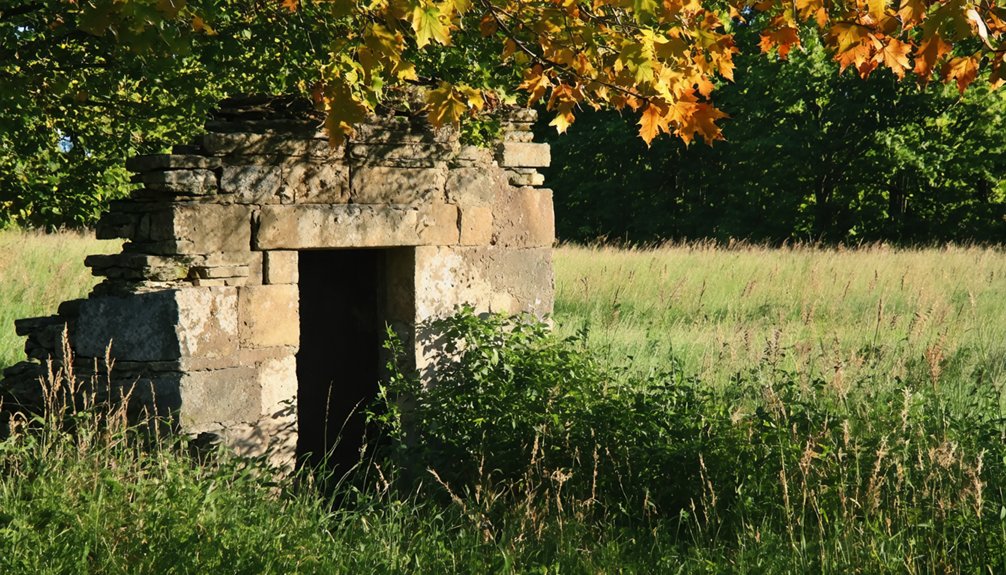
Underground Railroad activities near Tremont linked to broader networks throughout Indiana, with routes connecting to major hubs like Madison and Newport.
While detailed records of Tremont’s specific role remain limited, you’ll find that nearby areas like New City West played a part in the broader Underground Railroad network that helped enslaved people seek freedom.
The Historical Significance of this region lies in its position along hidden trails that wove through Indiana’s forests and swamps.
These secret pathways connected to established routes running from southern Indiana northward toward Michigan.
Though Tremont itself wasn’t a major hub like Newport, where Levi Coffin aided over 2,000 fugitives, the town’s location made it a potential waypoint for those traveling the dangerous path to freedom through Indiana’s complex network of safe houses.
Natural Forces and Urban Development
While Tremont’s founders envisioned a thriving lakeside metropolis to rival Chicago, the town’s location proved challenging from the start. Built on sandy, low-lying terrain along Lake Michigan, Tremont’s urban resilience was constantly tested by nature’s raw power.
- The shifting dunes and erosion repeatedly threatened infrastructure, swallowing roads and even cemeteries.
- Poor soil quality made agriculture nearly impossible, limiting the community’s self-sufficiency.
- The devastating 1853 forest fire destroyed most structures, accelerating the town’s decline.
- Environmental reclamation happened swiftly – by 1929, nature had reclaimed most of the original infrastructure.
You’ll find that Tremont’s story serves as a stark reminder of how natural forces can quickly override human ambitions, transforming bustling settlements into ghost towns within a single generation.
Preservation in Indiana Dunes State Park
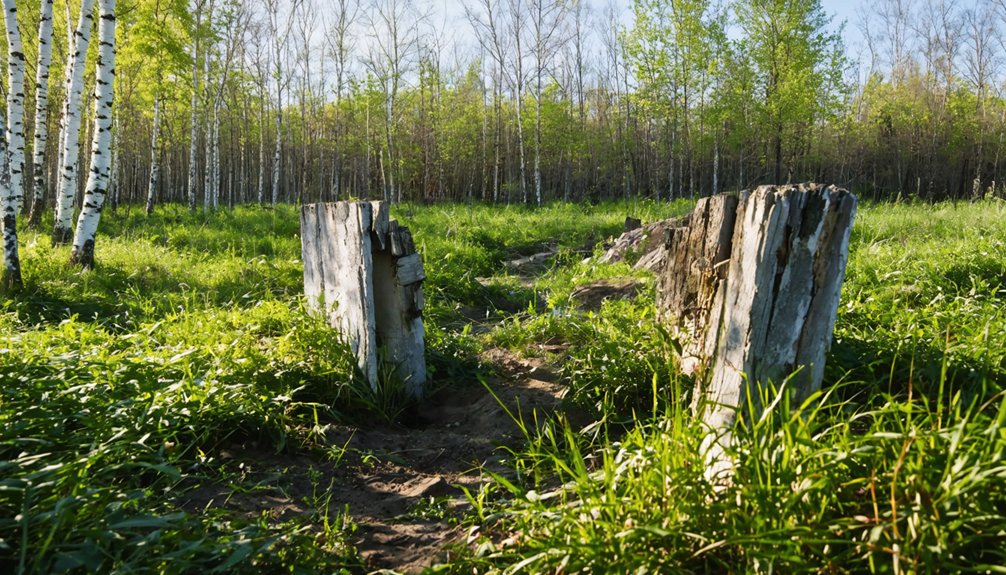
Before Tremont vanished beneath the sands, conservation efforts emerged to protect the unique duneland ecosystem that would become Indiana Dunes State Park.
You’ll find that early dune preservation efforts gained momentum in the 1920s, when scientists like Henry Cowles highlighted the area’s ecological impact through groundbreaking studies.
The state park’s establishment in 1925 marked a significant victory against industrial development, though the fight wasn’t over.
As you explore the dunes today, you’re witnessing the legacy of determined activists like Dorothy Buell, who founded the Save the Dunes Council in 1952.
Their relentless advocacy led to federal protection in 1966 with the National Lakeshore designation, and ultimately, National Park status in 2019.
The preserved landscape you see now exists because local citizens refused to let industry claim the entire shoreline.
Lost Town’s Lasting Impact
After Indiana Dunes National Lakeshore absorbed Tremont in 1966, the once-bustling tourist destination transformed into a case study of conservation‘s human cost.
Today, you’ll find its legacy preserved in community memories and local museum exhibits, highlighting the delicate environmental balance between preservation and development.
- The town’s story serves as a powerful reminder of how conservation efforts can reshape communities.
- You can still trace Tremont’s footprint through historical records and remaining road patterns.
- Local historians and nature enthusiasts continue studying the area’s unique transformation.
- The site now attracts visitors seeking both natural beauty and historical significance.
While physical structures have vanished, Tremont’s impact endures through documented histories, oral traditions, and its role in shaping regional conservation policies.
The ghost town stands as a symbol of both loss and preservation in America’s environmental movement.
Frequently Asked Questions
What Happened to the Residents Who Were Forced to Leave Tremont?
You’ll find that residents scattered to nearby towns after government buyouts, with displacement effects splitting up tight-knit neighbors. Community memories live on through local historical societies and museum exhibits.
Were There Any Notable Crimes or Incidents in Tremont’s History?
You won’t find any documented historical crimes or unsolved mysteries in Tremont’s past. Unlike other ghost towns, its story centers purely on land acquisition and community displacement by the National Park Service.
What Was the Average Property Value in Tremont During Its Peak?
Picture sand-swept lots beneath towering dunes. You won’t find exact property values documented, but comparable land sold for several hundred dollars per acre during peak tourism periods of the mid-20th century.
Did Any Famous People Ever Visit or Stay in Tremont?
You won’t find any documented celebrity sightings in Tremont’s historical significance. While Chicago’s Prairie Club members frequently visited, there’s no evidence of famous figures staying in this modest duneland community.
What Native American Tribes Originally Inhabited the Tremont Area?
You’ll find the Miami and Shawnee tribes had the strongest tribal history in this area, though specific indigenous culture records for Tremont itself aren’t well documented beyond general regional presence.
References
- https://raregoldnuggets.com/?p=3933
- https://www.youtube.com/watch?v=ivff3mb7u4U
- https://www.atlasobscura.com/places/city-west-ghost-town
- https://gregandbirds.wordpress.com/2017/11/21/lost-to-nature-1-city-west-and-tremont-indiana/
- https://dunelandhistoricalsociety.weebly.com/duneland-ghost-towns-video-series.html
- https://en.wikipedia.org/wiki/List_of_ghost_towns_in_Indiana
- https://www.islands.com/1754423/city-west-ghost-town-abandoned-buildings-once-dreamy-town-indiana-coastal-eerie-dune-beach/
- https://www.inportercounty.org/Data/Misc/DreamCitiesOfTheCalumet-1929.html
- https://stephenjessetaylor.wordpress.com/2013/07/27/city-west-lost-metropolis-of-the-indiana-dunes/
- http://www.porterhistory.org/2017/01/lost-porter-county-city-west.html
